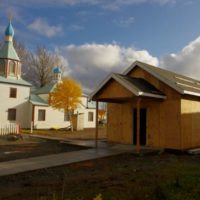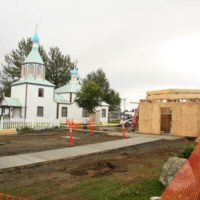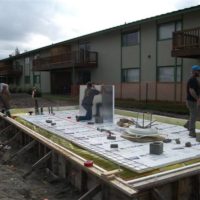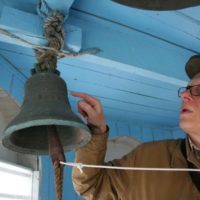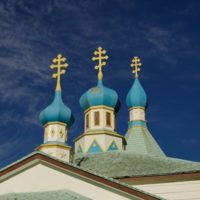
Project: Holy Assumption Orthodox Church, Kenai
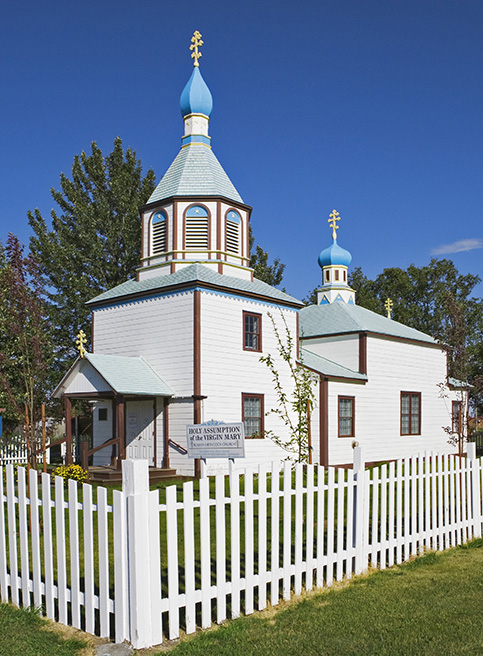
Current Campaign
We are continuing preservation work on the roof of the church, restoring the bell tower, developing a museum in the Narthex of the church, and completing a theft prevention system.
Preservation Status
ROSSIA is very pleased to report the completion of phases 1 and 2 of work on Holy Assumption, one of Alaska’s most visited National Historic Landmarks. Through grant awards from Save America’s Treasures (2008), National Trust for Historic Preservation (2010, 2011, 2012), Rasmuson Foundation (2010 and 2013), Alaska Historical Commission (2011), State of Alaska (2010 and 2013), and ongoing support from the City of Kenai, Kenai Peninsula Historical Society, and Kenai Historical Society much work has been accomplished.

Holy Assumption Orthodox Church in the news
July 21, 2020 | Landmark gets ‘new hat’: Church gets new roof, cupolas, crosses for 125th anniversary
Completed Work
During Phases 1, 2, and 3 ROSSIA completed the following:
• Stabilized deteriorated log walls
• Secured the building to its foundation
• Repaired the front porch
• Developed an accessible entry into the church
• Installed rough-in for fire suppression system
• Constructed an outbuilding, blessed with the name St. Juvenaly, to house a mechanical room, fire suppression equipment, and a restroom and gift shop
• Completed the installation of fire suppression system in the church to preserve the building itself and the icons within in the event of a fire, making it the gold standard of fire suppression systems in cultural properties.
Project Gallery
Church History
The Holy Assumption Orthodox Church has been the principal and most enduring representative of Russian culture in southcentral Alaska from 1841 to the present. For the Kenaitze Indians, who are still a significant portion of the population, it was the major institution for the assimilation of western culture when the Russian fur traders first came to the area. In addition to serving as a religious center, the church began the first school on the Kenai Peninsula educating the local Kenaitze children and young adults to read, write, grow vegetables, and learn basic building methods. It served as a judicial center acting as arbiter between the officials of the Russian-American Fur Trading Company and the natives. The church served as a social center, bringing the community together to share ideas and promote the welfare of all. The church also provided the region’s first access to public health with the introduction of smallpox vaccine after the first epidemic decimated the local population.
This property represents a complete historical resource because it has maintained its original, continued use by the community for over 150 years.
Architecture
All three structures, which contribute to the National Historic Landmark (NHL) site, represent classic Russian-style architecture on the far-western frontier. The church is a fine example of a Russian village church, designed in the classic Pskov, vessel or ship pattern. It is perhaps the most colorful of all Russian Orthodox churches in Alaska with its broad pallet of colors from pure white to blue, green, and gold on the exterior. The chapel is an excellent model of Russian techniques of log construction with its uncovered log walls that illustrate of the precise craftsmanship and engineering of the Russian-trained builders of the Kenai Peninsula. The rectory is typical of the homes of the Russian village gentry and at the time of its construction was clearly a substantial landmark, being the only two-story structure in the community.
Icons & Artifacts
The icon and artifact collections date from the early 1700’s when the first group of Russian missionaries came to Alaska. With the exception of three icons, all were written in Russia and transported to Kenai. The oldest icon, “Our Lady of Kazan,” is believed to have been written in the early 1700’s and brought to Alaska by the first missionaries in Kodiak Island. It is one of the oldest pieces of non-native art in the state of Alaska. The three icons that are not of Russian origin are rare examples by the native Aleut iconographer Gregori Petukhov who studied under Bishop Veniaminov, Enlightener of the Aleuts and Bishop of Sitka, who later was consecrated St. Innocent.



